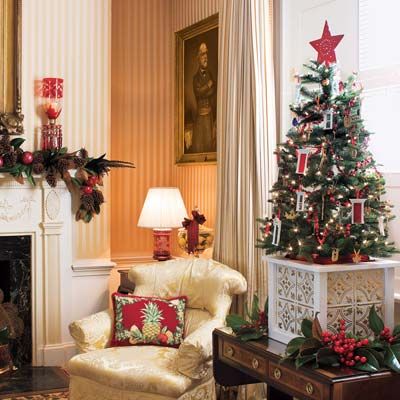We may be compensated if you purchase through links on our website. Our team is committed to delivering honest, objective, and independent reviews on home products and services.
Project details
Skill
Cost
Estimated Time
A Christmas tree box can be a delightful and functional enhancement to your holiday decor. It not only elevates the appearance of your tree but also provides a stable base while concealing an unsightly stand. This guide will lead you through building a charming Christmas tree box, creating a cherished part of your holiday traditions.
*Unless otherwise noted, costs in this article reflect an average of prices that our team found from hardware stores like Lowes and Home Depot, and on Amazon.com.
Step-By-Step Instructions to Build a Christmas Tree Box
If you’re eager to add a personal touch to your festive decorations, this DIY project is just what you’re looking for.
Construct the Legs
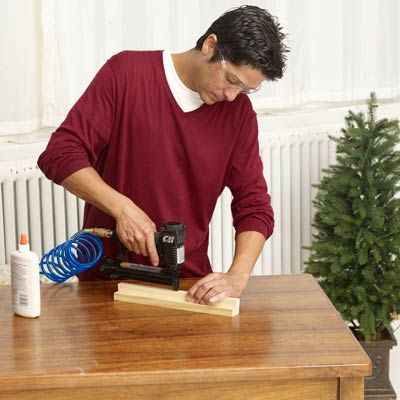
The initial step in creating your Christmas tree box is constructing the legs, which will form the foundation and determine its overall height. Here’s what you’ll need to do:
- Cut four 1×2 strips to a length at least 4 inches taller than your tree’s pot.
- Cut four 1×1 strips to match the length of the 1×2 strips.
- Apply wood glue along the long edge of each 1×2 strip.
- Align a 1×1 strip flush with the glued edge of each 1×2 strip, forming a sturdy L-shape.
- Secure the pieces together using a pneumatic pin nailer, placing pins every 6 inches along the length.
Give the glue ample time to dry completely before proceeding. This ensures the legs can adeptly support the weight of the box and tree.
Start Shaping the Box
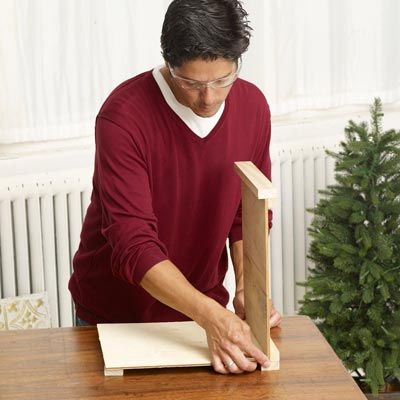
With the legs constructed, the next task is to begin shaping the box by cutting and attaching the side panels.
- Measure the width and height of your tree’s pot to ensure a snug fit.
- Cut four panels from 1/4-inch plywood, with two panels 1/2 inch narrower than the other two.
- Ensure all panels match the height of the legs you previously constructed.
- Apply wood glue to the inside edges of two legs.
- Position one of the wider panels inside the two legs, ensuring it sits flush with their outer edges.
- Secure the panel to the legs using the pneumatic pin nailer.
Precision is important in this phase, as accurate cuts and careful assembly will impact both appearance and stability.
Complete the Body
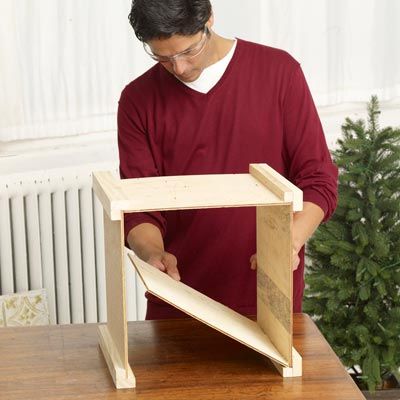
Once the first panel is attached, it’s time to complete the box’s structural body. This will involve fitting the remaining panels carefully for a seamless design.
- Attach the remaining panels between the legs, alternating wide and narrow.
- Apply wood glue to the inside edges of the legs before securing each panel.
- Use the pneumatic pin nailer to fasten each panel, ensuring a snug fit.
- Make sure the narrow panels face one another, as do the wide panels.
- After securing the final panel, the box should be open at both ends, creating the basic structure.
Ensure the panels are securely attached and that the box is square. Before advancing, make any necessary adjustments to achieve a balanced and stable construction.
Support the Bottom of the Box
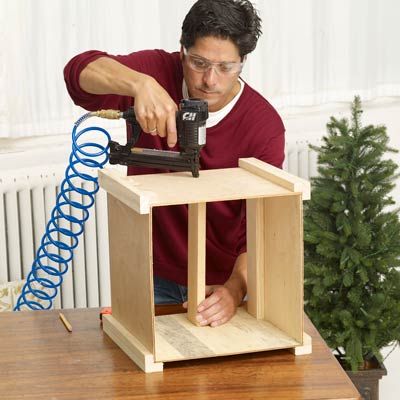
Adding supports to the bottom of the box creates a stable base for your tree pot. These components will provide overall stability to the finished product.
- Measure the height of your tree’s pot and mark a depth line inside the box, allowing for extra space beneath the pot.
- Cut three pieces of scrap wood to serve as blocking supports.
- Apply wood glue to the ends of each blocking piece.
- Place two blocking pieces at either end of the box, below the marked line.
- Secure a third blocking piece centrally, at the same height as the others.
- Use the pneumatic pin nailer to fix all blocking pieces firmly in place.
With the supports in place, the bottom panel will be secured, providing a solid foundation for your tree.
Attach the Box’s Bottom Panel

The next step is to secure the bottom panel of the Christmas tree box, providing a stable resting place for the tree pot.
- Measure the interior dimensions of your existing box frame.
- Cut a piece of 1/4-inch plywood slightly smaller than the measured dimensions for an easy fit.
- Apply wood glue to the tops of your support blocks.
- Carefully insert the bottom panel into the box, allowing it to rest securely on the support blocks.
- Use the pneumatic pin nailer for additional stability and to secure the panel in place.
The bottom panel facilitates easy maintenance of your tree.
Trim the Bottom of the Panels
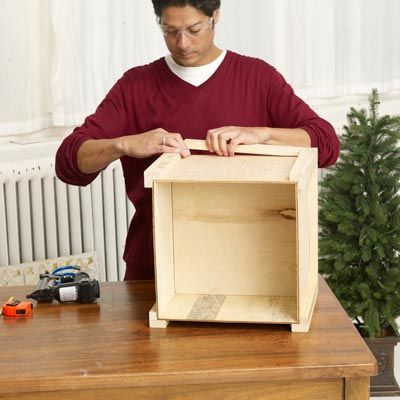
Adding bottom trim to your Christmas tree box balances aesthetic appeal with structural reinforcement.
- Measure the distance between each pair of legs at the box’s base.
- Cut four 1×2 strips to these precise measurements.
- Apply wood glue to one side of each strip, focusing on even coverage.
- Position each trim strip along the bottom edge of a panel, snugly fitting between the legs.
- Secure each strip with the pneumatic pin nailer.
- Continue this process for all sides to create a complete and polished look.
The bottom trim not only adds to the visual appeal but also protects the edges of the plywood, contributing to the box’s durability and finished appearance.
Prepare the Tin
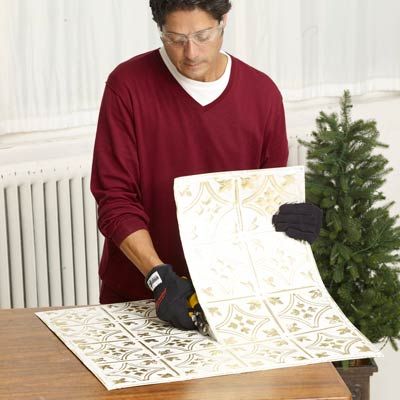
Incorporating decorative tin panels infuses your Christmas tree box with vintage charm and a distinctive character. This preparation stage ensures a seamless installation.
- Take precise measurements of each panel’s dimensions on your box.
- Choose tin ceiling tiles that mirror your decor style (standard 2-by-2-foot tiles work well).
- Employ tin snips, cutting carefully to create panels that snugly fit within your box’s frame.
- Equip yourself with protective gloves to avoid injury from sharp tile edges.
- Test the fit of each tin piece, making adjustments as needed to ensure accuracy before adhering them to the wood frame.
Planning and meticulous measurements prevent unnecessary material waste.
Insert the Tin
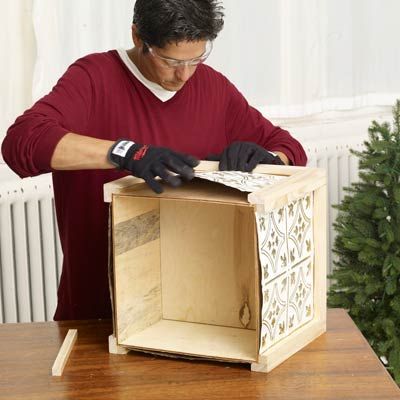
Attaching the prepared tin panels is a vital step, marrying structure with aesthetics for a striking holiday feature.
- Clean the back of each tin panel with rubbing alcohol to eliminate oils or debris.
- Apply vinyl adhesive caulk in a zigzag pattern across the back, ensuring even coverage.
- Precision position each tin piece inside the frame, aligning carefully with the plywood.
- Use light pressure to bend the tin slightly if necessary for optimal fit between the legs.
- Firmly press each tin panel against the plywood for secure adhesion.
- Use a caulk gun to apply a thin bead of caulk around the tin’s edges, sealing firmly.
- Repeat for each side of the box, maintaining even and careful alignment.
Allow the adhesive to dry completely, ensuring the box is fully ready for the final assembly touches.
Add Supports to the Top Interior of the Box
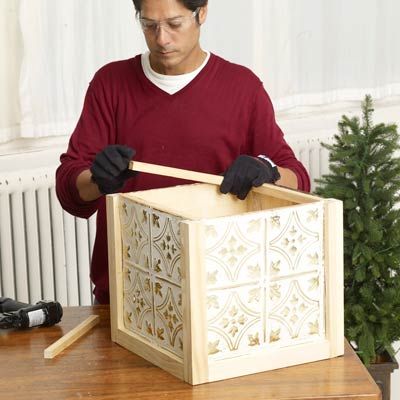
Adding interior supports provides the structural integrity needed for the top cap.
- Cut four 1×2 lumber pieces to fit securely inside the top of the box.
- Apply wood glue to one side of each piece for secure placement.
- Position each support flush against the box’s top edge inside.
- Utilize the pneumatic pin nailer to securely fix each support in place.
- Ensure uniformity by checking supports are level and aligned.
These internal supports are essential for providing a reliable base for the future top cap.
Cap the Box
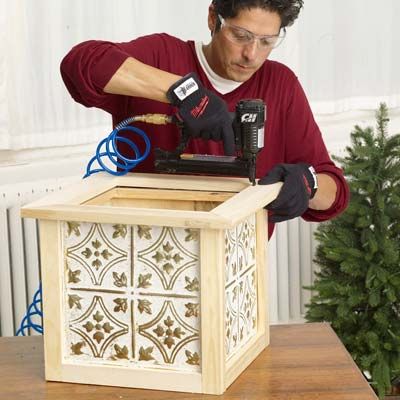
A top cap finishes the Christmas tree box, adding elegance and cohesiveness to the entire structure.
- Carefully measure the external dimensions of the box, accounting for leg extensions.
- Cut four pieces of 1×4 lumber to these measurements, mitering corners at 45 degrees.
- Test the fit to ensure accurate alignment and a perfect square.
- Apply wood glue along the box’s top edges and internal supports.
- Fit the mitered 1×4 pieces firmly in place, verifying that corners align precisely.
- Use the pneumatic pin nailer to secure the top cap, ensuring a tight fit.
- Promptly wipe away any glue excess with a damp cloth for a neat appearance.
This cap completes your tree box.
Finish the Piece
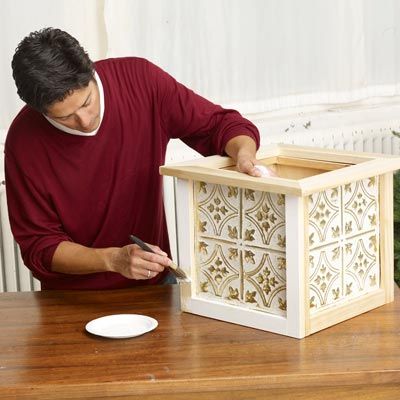
The final step to crafting your Christmas tree box involves a finishing touch that showcases both your handiwork and personal style.
- Smooth all wood surfaces and edges using medium-grit sandpaper.
- Wipe away lingering dust with a tack cloth for a spotless surface.
- Apply a coat of primer generously to all wooden parts, allowing for complete drying.
- Lightly sand again with fine-grit sandpaper and remove any resulting residue.
- Choose a latex paint color that matches your holiday decor scheme.
- Carefully apply two paint coats, ensuring adequate drying time between layers.
- Consider a protective clear sealant application once the paint fully cures.
These final steps ensure your Christmas tree box is not only eye-catching but also protected, maintaining its beauty and functionality over time.
Required Tools to Build a Christmas Tree Box
 Jigsaw
Jigsaw Tin snips
Tin snips Pneumatic pin nailer
Pneumatic pin nailer Miter saw
Miter saw Combination square
Combination square Tape measure
Tape measure 1 1/2-inch paint brush
1 1/2-inch paint brush Nitrile gloves
Nitrile gloves
